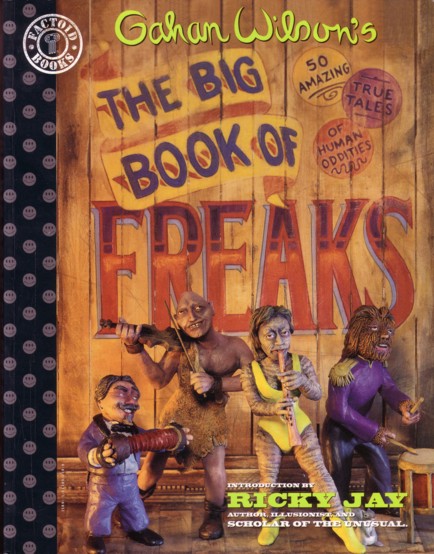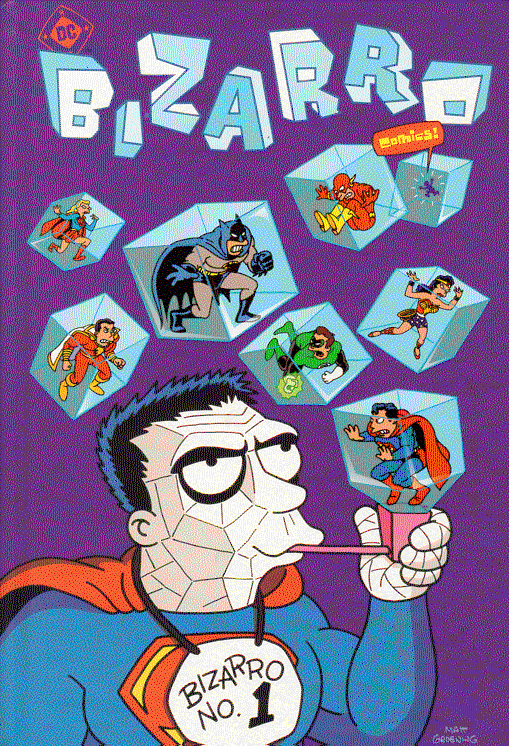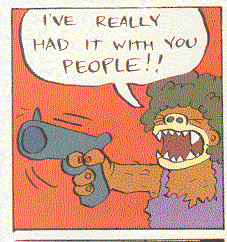This is an absolutely wonderful series of books that has been put out by DC for the past 8 or so years. Informative as hell and thoroughly entertaining, I have almost all of them and haven’t seen a bad one yet. If you feel like you haven’t gotten enough out of any particular story, there is an extensive bibliography at the back of each volume. Buy as many as you can, you won’t regret it. These are also an example of that rare breed of comic that non-comic people also enjoy.

Yes, I’m finally getting around to reviewing a Big Book. It only took me about 3 years after I put the page up, but it turns out that there are a lot of mini comics coming out on a regular basis, and that’s what the page is all about, after all. This is just in case there’s anybody out there who still doesn’t know about this marvelous series. What they do is take a subject (scroll around for more of the titles) and examine it from every angle, using a variety of some of the best comics illustrators out there. Here’s a partial list, leaving aside the fact that the whole thing is put together by Gahan Wilson, and shame on you if you don’t know who he is: Bob Fingerman, Hunt Emerson, Renee French, Ivan Brunetti, Rick Geary, and Glenn Barr, along with about 40 others that you’ll probably recognize at least a little bit but be unaware where you recognize them from, if you’re anything like me. Anyway, obviously, this one is all about freaks throughout the ages. Yes, they deal with the politically correct way you’re supposed to say “freaks”. In here you have ancient legends about giants and other oddities, freaks of nature like Chang and Eng (the first Siamese twins, and the reason that they’ve all been called “Siamese” since) and the Elephant Man, P.T. Barnum and his business dealings, flea circuses, snake charmers and “geeks”, bearded women and tattooed men, faked freaks, and personal lives of freaks such as Zip, Baby Ruth, Lobster Boy, and the gentle giant of Alton, Illinois. Whew! There are pieces, here and there, where you wish for a bit more personal detail, but there’s not going to be a lot of personal detail with a lot of these stories because it’s ancient history in a lot of cases and their real stories were usually closely guarded, so as to avoid people finding out the truth. That’s the only minor complaint I have with this book, however. If you’re curious about anything above what’s in here, there’s an extensive bibliography in the back. I love the fact that it’s a different artist for every story, as it gives a lot of incredibly talented people a chance to give their interpretations of many, many odd people. I remember this as being one of my favorites of the bunch, and I’ll probably put up a few more reviews before three more years pass, but I have to point out again how wonderful these books are. Anybody, comics fan or not, can pick one of these up, read it for a few hours, and come away knowing somewhere between a lot and a little more than they started with. There were a few things I picked up this time that I hadn’t before, and I’ve read this thing probably three times. A fantastic, indispensable book, and cheap enough at $14.95 that it’s hard to resist. If you haven’t seen any of these before, and you don’t have a weak stomach, I’d say start with this one.

Big Book of the Weird Wild West

Well, the book I’ve been holding my breath for since I heard about it in the planning stages is finally here. All the best small press people, all in one book! All Bizarro stories, all the time! Little seen talents finally getting a chance to shine on the big stage! And the end result is… mixed.
Oh, don’t get me wrong, there are moments in here that make it worthwhile, enough so that I can recommend getting it. You could probably wait for the softcover to come out and save $10 or so, because there’s nothing in here that couldn’t wait a few months. If you don’t know the concept, DC apparently decided to give all these “no name” people a chance. If anybody knows the complete story behind this book, let me know. I’m curious as hell to see how this got organized. And whose decision was it to put pairings on all of the stories instead of just letting one person shine? Granted, some of the pairings boggle the mind: Dylan Horrocks and Jessica Abel, James Kochalka (writing and not drawing!) and Dylan Horrocks, Jef Czekaj and Brian Ralph, Eddie Campbell and Hunt Emerson, Ivan Brunetti and Evan Dorkin, Evan Dorkin and Steven Weissman… it’s a hell of a list, don’t get me wrong. But most of these guys spend their time doing their own thing and I think it would have flowed a lot better if they had been allowed to do that here. Granted, you would have to bring in a color guy for most of these people that have never used it, but they do everything else themselves.

The story (such as it is) is this: a creature called A comes to Mxyzptlk’s world to try and take over. He challenges M to a best-of-seven of games, but M is disqualified and has to choose a champion. Remembering his past problems, he chooses Superman but can’t find an appropriate alternate universe substitute after the original one doesn’t believe him, and accidentally chooses Bizarro. Make sense? It doesn’t matter. Bizarro decides to win the contest by drawing a bunch of stories, and these stories are all the ones by the small press folks. When it goes back to the “story”, these comics are promptly forgotten about and the challenges begin, but not before they get an insult or two off about the quality of the comics. Which, I’m sure, is just an insult in the story directed at Bizarro and not the creators, but it’s pretty easy to take it the wrong way. The main story takes up about 60 pages of a 236 page book, which wouldn’t be that bad if it didn’t mostly suck. It has a few moments, but the thought that this story was expanded upon at the expense of some of these extremely talented guys doesn’t make sense at all to me.
Flipping through this again to write this, I see that I enjoyed almost all of the shorts in this. I didn’t really like Wonder Girl vs. Wonder Tot, Help! Superman!!, Batman, and The Most Bizarre Bizarro of All! Compare that to the 23 other stories that I liked a lot, and it looks like they have a winner here. The Bat-man (by Chip Kidd and Tony Millionaire and strangely, the only black and white story in the book) is brilliant. Old school classic Batman here, and he’s ugly as hell. Hawkman (James K. and Dylan Horrocks), while not drawn by James, has the same feel that I’ve come to know and love from all his work. Kamandi (Nick Bertozzi and Tom Hart) takes the cake for me as the best story in the book, but I’m hopelessly biased because Tom Hart drew it. That’s Really Super, Superman (Ivan Brunetti and Evan Dorkin) is a close second, and First Contact (Mark Crilley and Andi Watson), about the Atom, is up there too.
I was expecting a hell of a lot from this book, and I’m not sure that I got it. What I did get, however, is a thoroughly entertaining look at a lot of DC universe told through the eyes of some of the most talented people working in comics today. If I cared at all about the characters this probably would have been a great book, or maybe if they had allowed them to work by themselves, or maybe if DC had given them a little more room (and a lot more people. The names excluded here are too numerous to mention, although I am surprised and gratified by some of the selections) to the creators. All in all, if you like even half the people in this book, get it. If you like Evan Dorkin, Sam Henderson or Dylan Horrocks, they’re all in here a few times writing and drawing but not, as I’ve made pretty clear by now, doing both things at once. The Matt Groening cover makes the book, too. And yes, I did see the Dan Clowes cover in The Comics Journal and I thought it was great, but I think this is a better cover for the tone of the book.



 Posted by Kevin
Posted by Kevin 




